Arkansas’ Razorback Regional Greenway
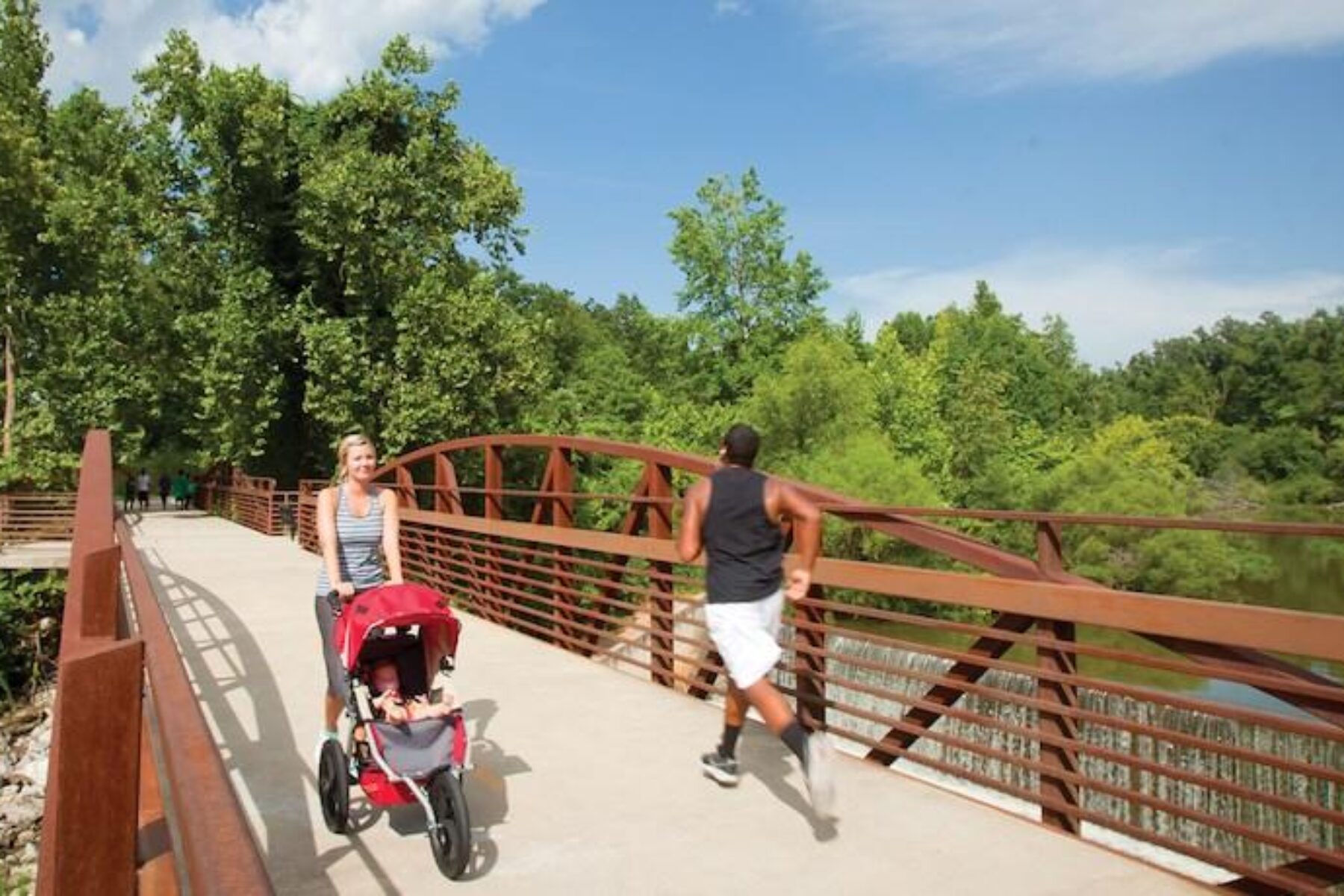
This article was originally developed for the Fall 2022 issue of Rails to Trails magazine. It has been reposted here in an edited format. Subscribe to read more articles about remarkable rail-trails and trail networks while also supporting our work. Have comments on this article? Email the magazine.
Trail of the Month: July 2023
“Trails help improve quality of life in Northwest Arkansas by helping us preserve open spaces, connecting our region and spurring economic development in local communities.”
—Jeremy Pate, senior program officer of the Walton Family Foundation Home Region Program
Whether he’s going to work or out to eat with his family, Fayetteville resident Matt Mihalevich often hops on his bicycle and rides the Razorback Regional Greenway in Northwest Arkansas to get there. “It’s a fun way to get around instead of being on autopilot in the car,” he said.
Mihalevich isn’t alone. Each month, tens of thousands of residents and visitors walk or roll along the greenway, which spans nearly 46 miles and connects seven communities in the region, including Fayetteville, Johnson, Springdale, Lowell, Rogers, Bentonville and Bella Vista. The trail network opened in 2015 and was developed through a public-private partnership with each city’s government and the Walton Family Foundation.
“That’s what’s special,” said Mihalevich, who serves as the City of Fayetteville’s active transportation manager. “The greenway goes through the heart of these rapidly growing communities in Northwest Arkansas. So, you get a little taste of each of these cities it passes through, and that’s what gives it strength and is unique for visitors to experience.”
The multiuse, paved greenway has become a popular recreational amenity in Northwest Arkansas. Trail users encounter parks, streams and lively downtowns along the way, and have easy access to restaurants, bike shops and other retail establishments. Major attractions, like the Crystal Bridges Museum of American Art in Bentonville and the University of Arkansas in Fayetteville, also draw people to the trail.
City leaders plan to expand the greenway so that residents can more easily access trailheads and use the network for transportation, especially as the population of Northwest Arkansas—which is home to large corporations like Walmart and Tyson Foods—continues to grow. In 2020, the Razorback Greenway Alliance was formed to standardize the trail’s maintenance, create a cohesive brand image and ensure the trail remains viable for the future.
Built By Public-Private Partnership
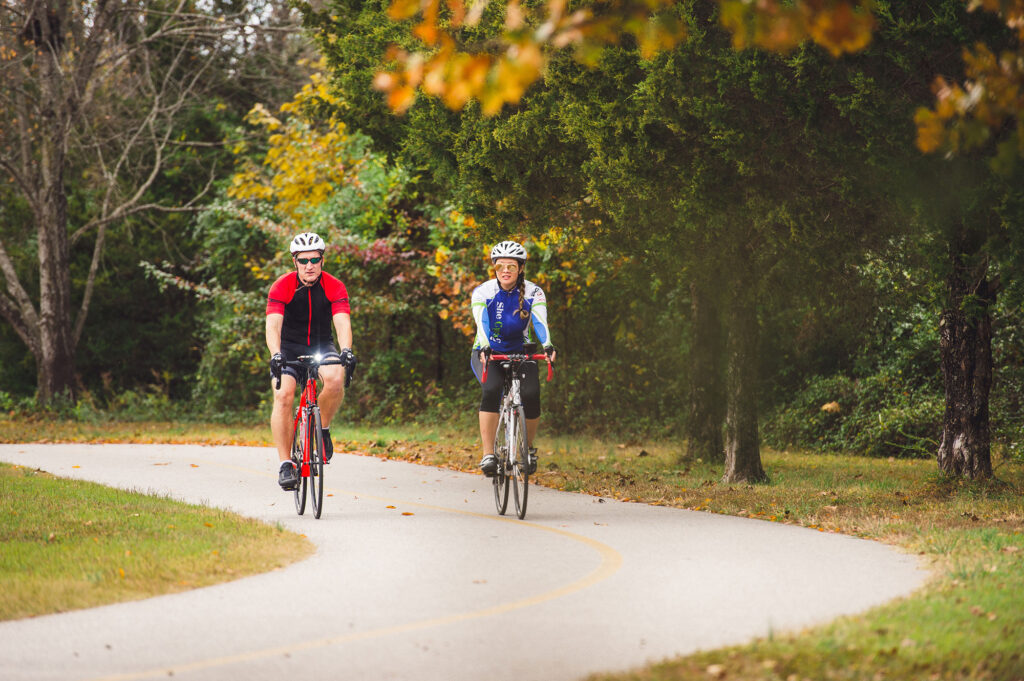
The goal of the Razorback Regional Greenway was to join many of Northwest Arkansas’s existing trails together to create a seamless recreational and transportation corridor, Mihalevich said. Today, the greenway route is comprised of 22 individual trails.
Around 2010, the Northwest Arkansas Regional Planning Commission, the local metropolitan planning organization, started a committee to develop the master plan for the greenway. With a $15 million federal grant from the U.S. Department of Transportation—matched by the Walton Family Foundation—the project was able to move forward, and was designed and built by Alta Planning + Design and other experts.
“It certainly helped the cities get on board when it had financial backing,” Mihalevich said. “They were absolutely on board. It’s been great to see how the community, the citizens, the residents and the visitors have all just embraced it.”
The project involved building new trails, connecting them to existing trails and updating some older trails, explained Erin Rushing, CEO of Trailblazers, a nonprofit that develops multiuse trails and advocates for active transportation in the region.
“We had strong leadership within the cities, and they had a vision,” said Rushing, who’s based in Bentonville and was part of the greenway’s planning process. “It was pretty cool to watch it come together.”
The cities along the greenway have continued investing in their trail systems and maintained their portions of the greenway. The Razorback Greenway Alliance was formed to create an official agreement for the trail’s future, said Tristan Hill, the Razorback Greenway’s manager and the Alliance’s only paid staff member.

“They were starting to see some wear and tear on the trails and general maintenance things that need to be kept up with, so the cities decided the best way to handle that would be to create a governing body for the greenway,” Hill said.
The Razorback Greenway Alliance, a nonprofit mostly funded by the Northwest Arkansas Regional Planning Commission, includes a representative from each city on the greenway. This year, the Alliance is working on several projects, including a brand refresh and new logo, coupled with a stronger online presence for the greenway. An updated website launched in 2022 and featured an interactive trail map.
Related: How Funding for Trails Moves America: 5 Trails Funded by TIGER
A Regional Asset
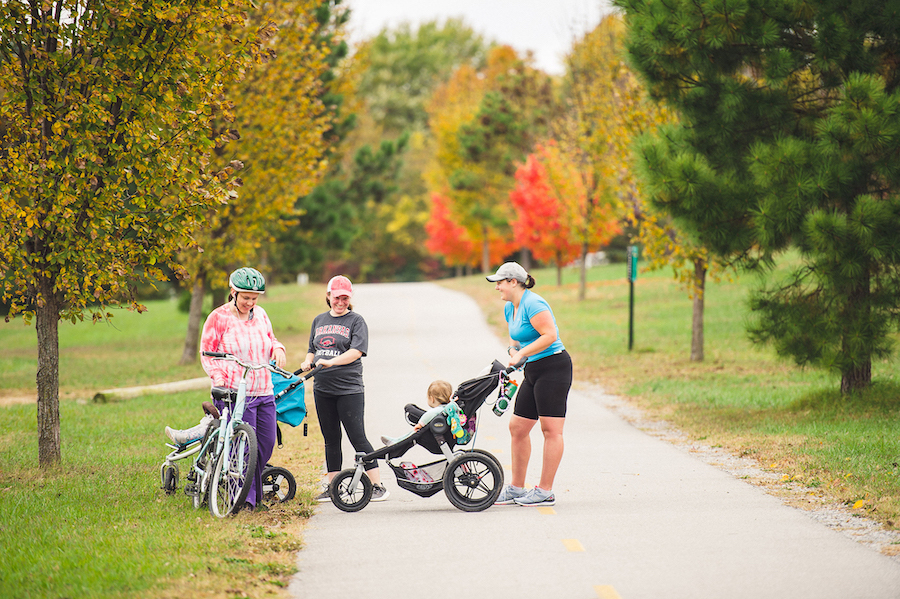
Northwest Arkansas is one of the fastest-growing areas in the nation. City officials say the region’s cycling culture and trails like the Razorback Greenway are a draw for tourists and new residents, bringing financial, health, transportation and tourism benefits to the region.
According to Walton Family Foundation research, cycling provided $137 million in economic benefits to Northwest Arkansas in 2017, which is the most recent data available. As of 2020, the organization has contributed $74 million to developing shared-use paved paths and on-street cycling infrastructure in the region, including $15 million to support the development of the Razorback Greenway.
“Trails help improve quality of life in Northwest Arkansas by helping us preserve open spaces, connecting our region and spurring economic development in local communities by being an attraction for locals and visitors alike,” said Jeremy Pate, senior program officer of the Walton Family Foundation Home Region Program.
Recreation—including bicycling, running and walking—remains a top use of the trail. But Rushing said he’s seeing more people using the greenway for commuting as well.
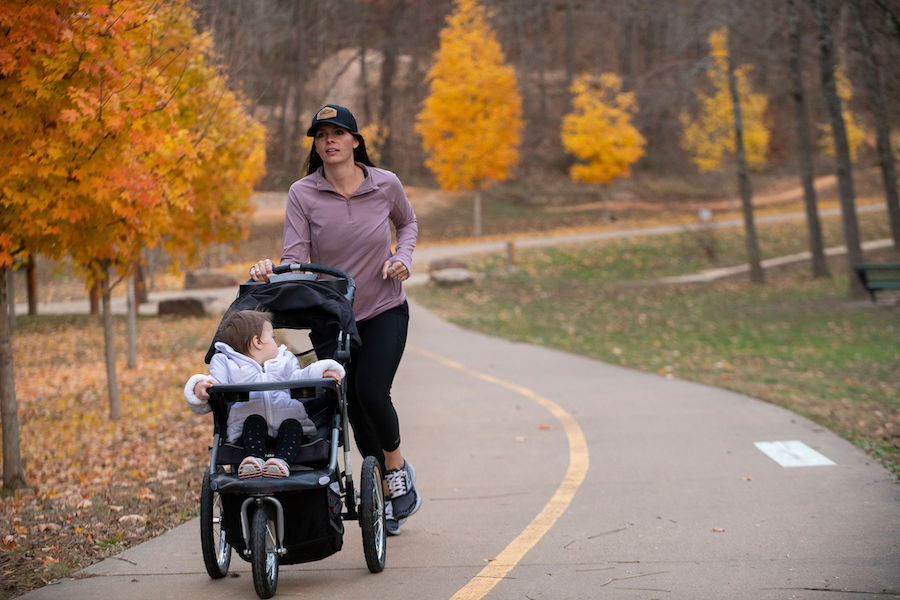
“Just having the ability to ride your bike to work or school or the grocery store or a concert is great,” he said, adding that some areas of the trail can see up to 50,000 users a month. New businesses, including bike shops, breweries, cafes and restaurants, have opened up along the trail, too.
Increasing the greenway’s transportation use is part of the Alliance’s goal, Hill said. The group is working on adding better lighting to the trail to make it more accessible to residents using it to get around at night. The lighting project is almost complete on the Fayetteville stretch.
“That’s a huge benefit to lower-income families, who might only have one car or might not have a car at all,” he said. “They can use the greenway. Since it runs through so many city centers, it’s a viable means of transportation.”
Variety is the Spice of (Trail) Life
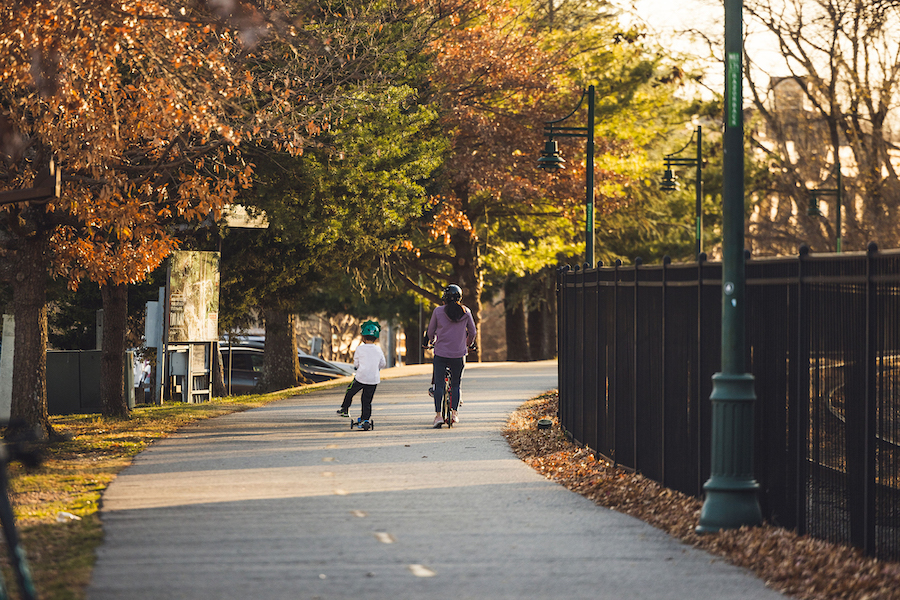
The Razorback Greenway experience is varied as you pass through different communities, Mihalevich noted. It runs along streams and includes flat and hilly portions. Sections feature bridges and green corridors, and some parts run along roadways with designated bike lanes.
“There’s the nature element of being out on the trails—there are good sections of the greenway that are beautiful and run through the woods,” said Hill, who enjoys cycling the trail. “There are also sections that run through downtowns if you want to be part of the city life. The greenway has an appeal for everybody—that’s part of what makes it so special.”
Older sections of the trail follow former railroad corridors, including Fayetteville’s Frisco Trail, which also parallels an active railroad for a portion of its journey. And the greenway follows some historically significant routes as well, including the Trail of Tears and Civil War paths.
Nestled in the Ozarks, the region is also home to many mountain biking trails, which attract bicyclists from all over the country. Rushing said the Razorback Greenway connects these trails, making them more accessible.
“You may jump on the greenway, ride it for 2 miles, and then get off and ride a mountain bike trail system,” he said. “It’s that spine that connects all of these recreational amenities.”
In 2022, the Alliance unveiled new signage along the trail, including new mile markers and maps.
“As Northwest Arkansas and the greenway have continued to grow, we realized it’s really important to have a regional presence for the greenway,” Hill explains. “Since it encompasses the entire region, we want it to be consistent throughout the entire 40 miles.”
A Trail Within Reach
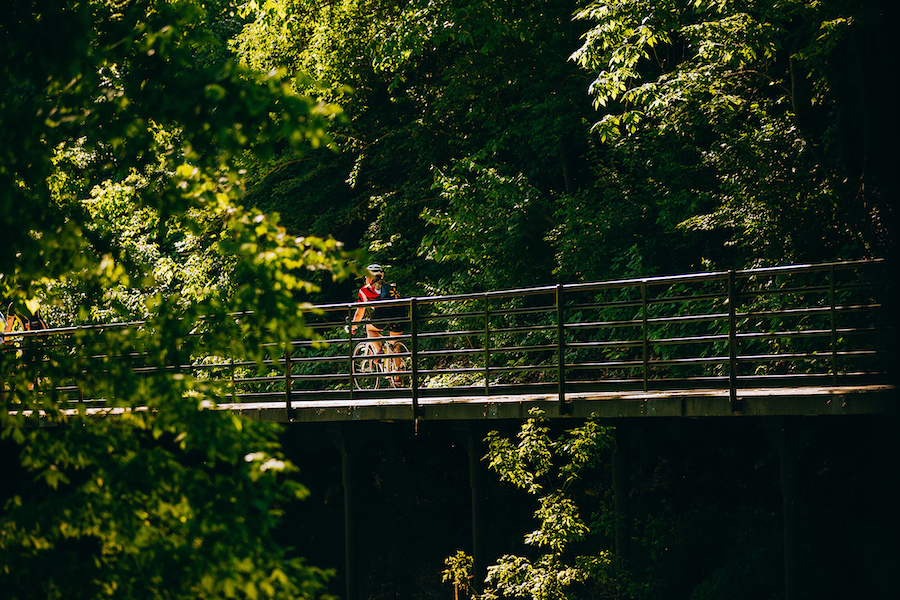
The Alliance and city leaders are working to ensure the greenway is never closed so that it’s always accessible to residents who rely on it for transportation—and, that any detours for flooding or construction are promptly posted online. They also plan to expand connector trails so residents can more easily reach trailheads from their homes.
“We’re trying to hit more rooftops,” Rushing said. “We built the spine, but now how do those people get from their homes to the trails safely?”
In Bentonville, he said they’re investing in on-street facilities, like more bike lanes. Mihalevich said 77% of Fayetteville residents now have access to a trail within a half-mile or 10-minute walk, and the goal is to expand that access to all residents.
“People don’t want to load up their bikes in their car and drive to a trailhead,” Mihalevich said. “If they could have the trailhead at their house, they can roll right out on their bikes.”
As Northwest Arkansas keeps growing, Hill said the Alliance is dedicated to meeting the demand for connectivity.
“We understand the importance of active transportation and alternative transportation,” he explained. “We want to continue to improve accessibility and commutability and everything that the greenway has to offer because it’s an incredibly special part of Northwest Arkansas.”
Related: Top 10 Trails in Arkansas
Cycling Culture Catalyst
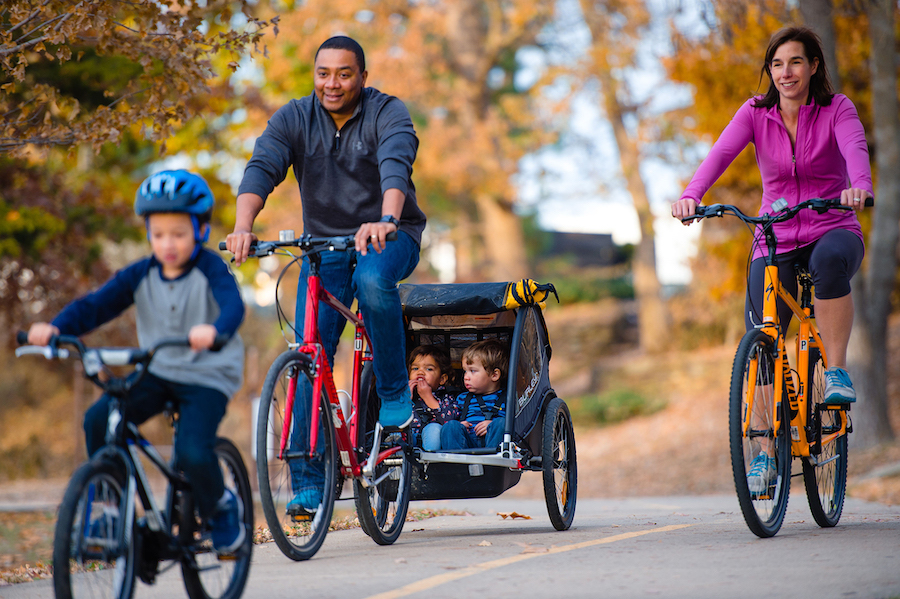
Biking is big in Northwest Arkansas. The activity is popular with residents, and the area has attracted major events, like the 2022 UCI World Cyclo-Cross Championships. Many in the region attribute the cycling culture to the Razorback Regional Greenway, which opened in 2015.
“We would not be what we are today without the Razorback Greenway,” said Erin Rushing, CEO of Trailblazers, a nonprofit that develops multiuse trails and advocates for active transportation in the region. “It started the momentum, and it’s our superhighway to connect all of these amazing bike trail systems.”
The Northwest Arkansas Tourism Association’s website boasts that the region is home to more than 250 miles of mountain biking trails, and the City of Bentonville even bills itself as the “Mountain Biking Capital of the World.” In 2017, Northwest Arkansas attracted more than 90,000 mountain biking tourists, according to a study by the Walton Family Foundation, an organization which has contributed $74 million developing shared-use paved paths and on-street cycling infrastructure in the region.
More than a quarter of residents regularly ride bikes—higher than the national average—and they spend millions on bicycling goods and events each year, the study found. Twice a year, the region hosts the Square 2 Square Bicycle Ride, to encourage residents of all ages to ride bikes and get out on the greenway.
Related Links
- Razorback Greenway Alliance
- Northwest Arkansas Regional Planning Commission
- Trailblazers
- Walton Family Foundation
Trail Facts
Name: Razorback Regional Greenway
Used railroad corridor: Portions of the trail parallel the active Arkansas & Missouri Railroad, a formation known as rail-with-trail. Other sections follow former (inactive) railroad lines, such as the St. Louis–San Francisco Railway.
Trail website: Razorback Greenway Alliance
Length: 45.8 miles
County: Benton and Washington
Start point/end point: Bella Vista to Fayetteville in Northwest Arkansas
Surface type: Asphalt, concrete
Grade: The trail is easy to moderate in grade with occasional hills.
Uses: Walking, biking and inline skating; wheelchair accessible
Difficulty: With a paved surface and numerous trailheads to access amenities and get on and off the pathway, the route is generally considered easy for most trail users.
Getting there: Fly to Northwest Arkansas National Airport (One Airport Blvd., Bentonville), located about 11 miles from the trail in Bentonville.
Access and parking: Parking for the Razorback Regional Greenway is available at dozens of trailside locations; here are a few options listed from north to south:
- Blowing Springs Trailhead (700 Blowing Springs Road, Bella Vista)
- Bella Vista Lake Trailhead (4900 Bella Vista Way, Bentonville)
- Bark Park Trailhead (2580 N. Walton Blvd., Bentonville)
- NW A St. Parking Lot (906 NE A St., Bentonville)
- Compton Gardens (312 N. Main St., Bentonville)
- Mercy Trailhead (S. Rife Medical Lane, 0.1 mile west of S. Promenade Blvd., Rogers)
- Runway Bike Park (922 East Emma Ave., Springdale)
- Lake Fayetteville North Trailhead (609 Lake Fayetteville Road, Fayetteville)
- Carol E. Van Scyoc Trailhead (6554 Wilkerson St., Johnson)
- Gordon Long Park Trailhead (2850 N. Gregg Ave., Fayetteville)
- Mount Kessler Trailhead (2600 W. Judge Cummings Road, Fayetteville)
To navigate the area with an interactive GIS map, and to see more photos, user reviews and ratings, plus loads of other trip-planning information, visit TrailLink.com, RTC’s free trail-finder website.
Rentals: For local bike rentals, check out the Visit Bentonville website and the NW Arkansas Travel Guide, which both list serval bike shop options.

Donate
Everyone deserves access to safe ways to walk, bike, and be active outdoors.
